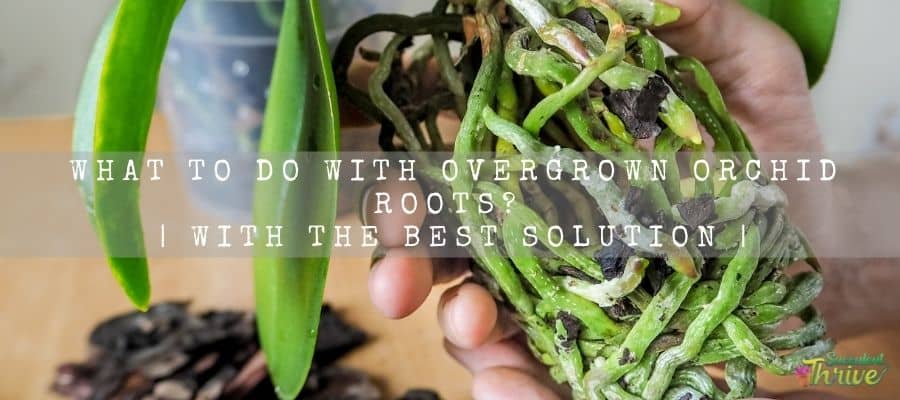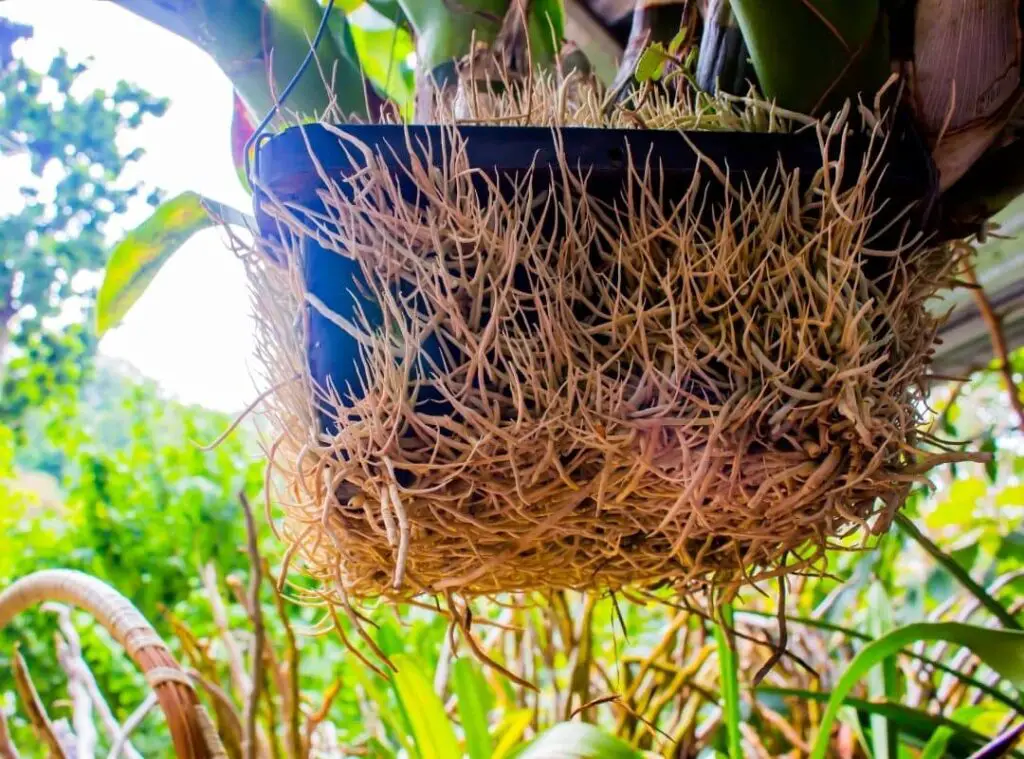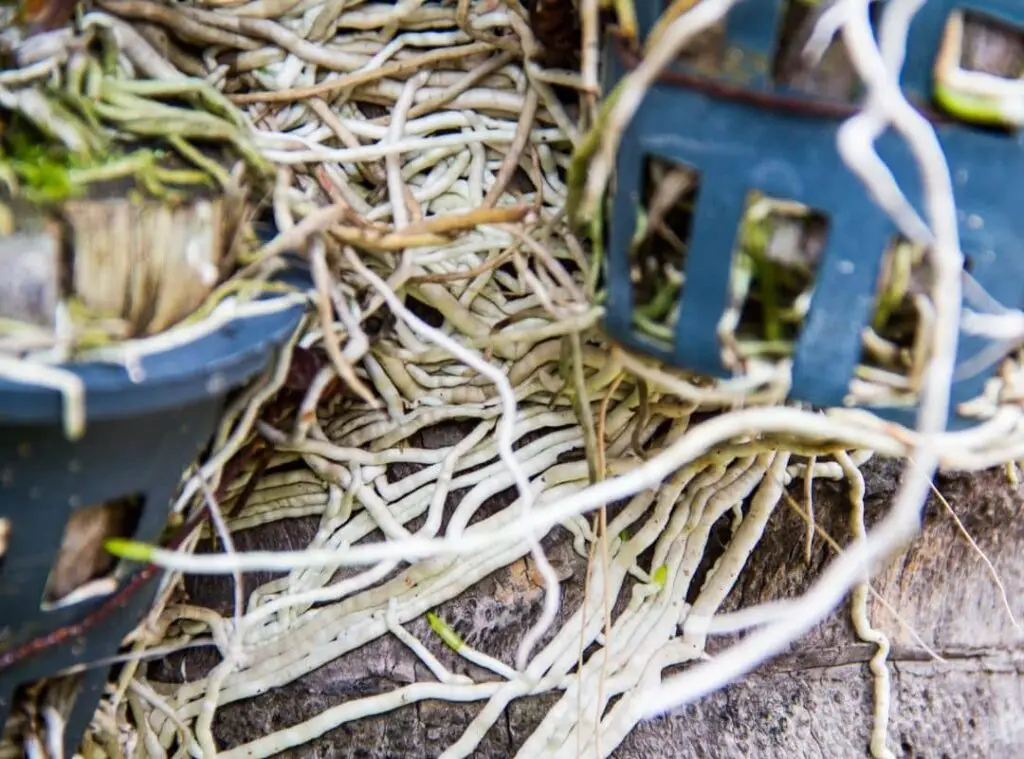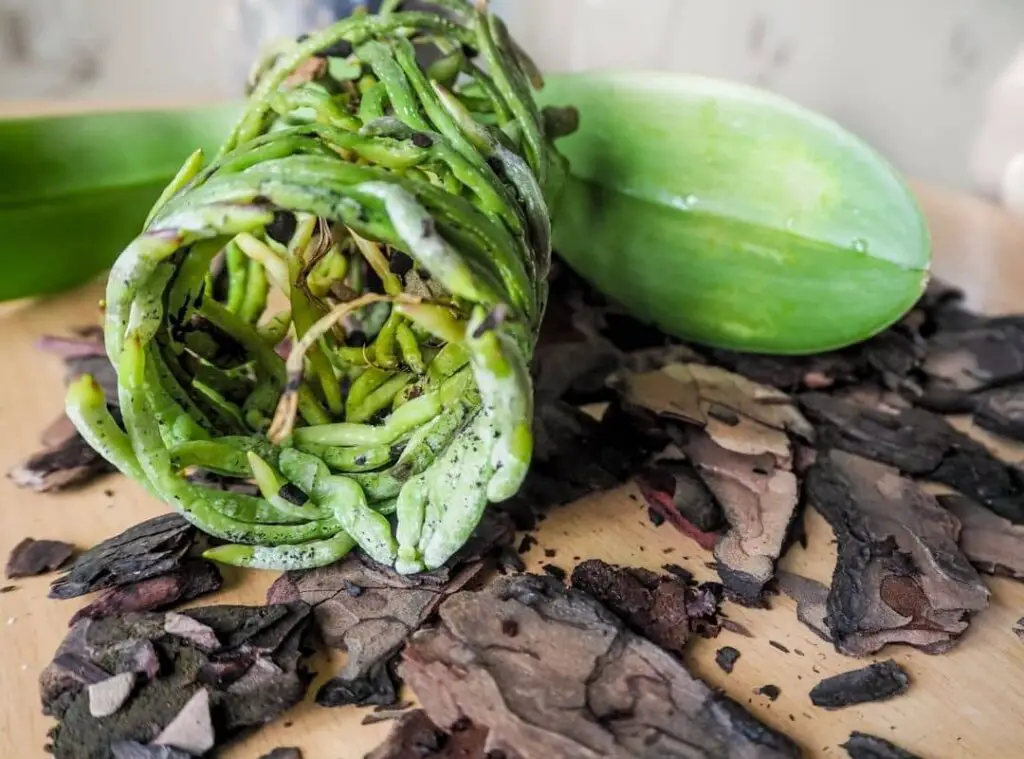Have you ever had a problem with overgrown orchid roots in your orchid garden? I guess the answer is yes. I had the same problem with my orchid plants.
In this article I am going to share some information, which may useful to get rid of overgrown orchid roots.

What To Do With Overgrown Orchid Roots?
The best solution is to repot the plant. Before go on to repotting here are some additional facts about orchid roots
Do you know about orchid roots?
Orchid roots usually grow in contrast to the rest of the other indoor plants. They are more dependent on the nutrients in oxygen than soil.
Moreover, they could grow above the soil surface and could make aerial roots.
If we consider the orchids which usually grow in their natural habitats which are rainforests, they tend to stay enclosed to the tree barks.
As such, when you grow them as houseplants, you could mimic their natural growing conditions by growing them in soilless potting mediums.
That will allow them the root systems to stretch out and grow. You could commonly spot orchids outgrowing them from their pots.
That could happen within a short period like in a couple of years. In this circumstance you could consider repotting them.
To elaborate further on the root system, if we take Dendrobium and Cattleya as examples, they comprise thick stems. You could call them pseudobulbs, and they would usually form on the base of the plant.
They would tend to grow towards the pot edge and ultimately, they would tend to grow over the pot side as well. That will make the roots look like they are out of control.
Those roots would be plump and firm to the touch and they would produce from the pseudobulbs.
In addition to that, it is necessary that you provide a new pot along with a fresh potting medium when the orchid roots become slender and brittle.

Why do Orchids have long roots?
Orchids usually prefer to be root bound. You could find long aerial roots in Phalaenopsis and among other epiphyte orchids.
Epiphyte orchids use aerial roots to absorb nutrients in the air. To elaborate more on epiphyte, it is what usually grows on other plants.
Moreover, Phalaenopsis orchids are not parasitic. Literally the orchids and the epiphytes which do not grow in soil tend to make air roots.
At the initial stage of the orchids which means during their seed stage, they tend to stay enclosed to the trees when they are moving around the air.
Further they tend to produce roots which would grip vigorously towards the tree.
You could usually spot them gripping to the tree bark for a height of about 1/3 of the tree. As a result, they could gain adequate sunlight due to.
They could not withstand the low level of sunlight. Usually when they are growing in rainforests, they usually get soil conditions which are not enriched with nutrients.
As such orchids tend to produce long aerial roots to find an alternate way of surviving. When they produce aerial roots, they can grasp nutrients which are remaining in the air.
Can you cut the overgrown roots off an orchid?
If they are healthy and outgrown from the pot, you do not need to trim them off. It is quite common to spot orchids forming aerial roots.
You could call them overgrown roots as well. They usually outgrow from the pot or from the container right into the air.
Once you spot them, you would feel like you need to shape them and snip them. However, it is a vital aspect of orchids’ growth.
When they are in the wild, their roots would form on the tree barks or out of moss. That will make sure the plant is well established and it is secured.
Moreover, those roots would also be accountable for nutrient absorption and for moisture absorption as well. That will make sure the plant feeds without depending on the traditional dirt.
However, as mentioned if your orchid air roots are white in color and firm to the touch, you may assume they are healthy roots.
Avoid trimming those roots. On the other hand, if you spot their roots are wrinkled and look rotten, you could assume they are not healthy roots. If you spot such roots, you should trim them off without any second thoughts.

Best solution: repotting
To start this off, first of all, I would think, the best time to proceed with repotting the orchids would be after they finished blooming. The reason behind it is that, only then they would resume to make new growth.
First take a newspaper and lay it down on a flat surface. Make sure you are using a clean newspaper for this process.
After that turn the orchid pot and give it a smooth touch on each side of the pot. That will make the root system and the old bark dislodge.
You could use a sharp and sterilized knife to loosen the old roots smoothly. Moreover, make sure that you segregate the roots and pry them away from the potting bark.
Chances are that sodden and mushy roots could drop easily. If not, you could even easily take them off as well whilst making sure that you do not harm the plant.
Give the root system a gentle shake and that will make sure the bark will fall away conveniently.
After that, you could go ahead and snip the dead roots. However, to do this, make sure that you are using pruning shears and small scissors.
Sanitize them before you use them. You could spot the dead roots as mushy and light brown in color.
On the other hand, you could spot the healthy roots white in color along with green growing tips. They would be firm to the touch.
You could go ahead and trim the pseudobulbs in orchids such as cattleyas. You could divide the plant whilst snipping them through a rhizome if you could spot more than one new growth.
When you divide the plant, make sure that it has about three pseudo bulbs and one new growth.

If you take orchids such as monopodial orchids like phalaenopsis and vandas seldom, best is to repot them in larger pots.
Furthermore, it requires new bark every couple of years. You could gently shake and take off the old potting medium and after that you could replace it with a new medium.
When you select the pot, make sure that your orchid could fit in that new pot for about a couple of years as it grows.
Ideally it has to be a couple of inches larger than the initial pot.
If you are using an old pot, ensure that you clean it well and soak it with a solution of chlorine for about half an hour.
After that let it become dry for some time. If you are using a new pot, soak it with water for a few minutes.
Moreover, you need to wet the potting bark whilst using boiling water. After that let it cool and allow it to drain as well. Apply a broken crockery or plastic foam peanuts to the pot base.
Hold the plant with one of your hands whilst you could use your other hand to place the bark around the roots. Make sure you firm the bark around the roots too.
You could place a chopstick into the bark. While you do this, ensure that the stem is secure. Finally, you could locate the new orchid pot in a partially shady location.
You could mist them twice until you could spot the new growth.
Read Next: How To Tell If Orchid Roots Are Dead? | 4 Important Facts |
